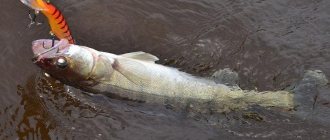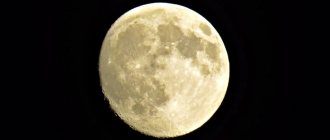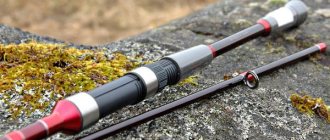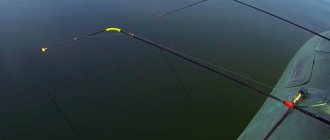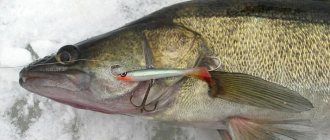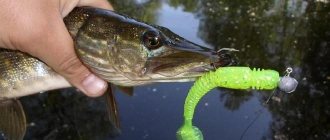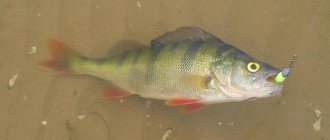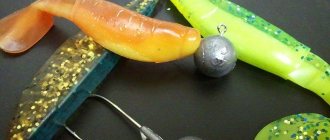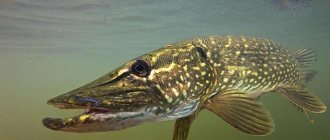Species composition of fish
The species composition of fish in the Moscow Canal is quite diverse. It contains many species of peaceful and predatory fish. However, the following trophies are more often found on fishermen’s gear:
- bream;
- roach;
- bleak;
- zander;
- asp;
- perch.
On this reservoir, fishing for bream using a feeder is very popular. Feeder fishing competitions are regularly held on the canal, so catching bream, spoiled with good bait and thin tackle, is not at all easy.
On a note! There is a current in the channel, and in addition, effective fishing often requires a long cast of the feeder, which leaves an imprint on the construction of gear and installation of equipment.
For this reservoir, you need a fairly powerful feeder rod with a test weight of up to 80 g. With such a rod, you can comfortably cast large feeders filled with food, and not worry that they will be blown away from the feeding point.
The length of the feeder should be no shorter than 3.9 m, which will allow you to make long casts and reduce the number of hooks on the feeder on steep riverbed edges. The feeder fishing rod is equipped with a 3500 series spinning reel, on the spool of which a braided cord with a diameter of 0.12 mm is wound. The bottom of the channel is rocky, so the presence of a fluorocarbon leader in the equipment is mandatory. Each fisherman uses his own installation of feeder equipment, but as practice shows, an asymmetrical loop works better on this reservoir. You need to constantly experiment with the leash length and hook number, depending on the activity of the fish and the strength of the current.
On the banks of the Moscow Canal you can always meet fans of feeder fishing
On the canal, bream is usually caught on the far or near edge of the channel. The nearest edge is located 25–30 m from the shore. To cast to the far edge, the angler will have to cast 50–60 m. The current on the canal is weak, so it is not necessary to add soil to the bait mixture.
Depending on the fishing season and the mood of the bream, it can bite on the following bait options:
- a bunch of 2-3 bloodworms;
- dung worm;
- bloodworms with maggots;
- maggot.
The best time for bream fishing on the canal is August and September. During these months, the capture of a trophy specimen is most likely.
Roach on the Moscow Canal are often caught on the feeder when fishing for bream. It is better to catch it purposefully with a fly rod. For fishing for roach, fly rods 5 and 9 meters long are well suited.
A 5-meter long rod allows you to catch small roach on a nearby underwater ledge. A longer fishing rod will allow you to reach the next “table”. The equipment for fishing this fish should be extremely light, and the length of the leash should be at least 20 cm.
Important! When fishing for roach on a canal, bait is of decisive importance, which must be constantly thrown into the water, not allowing the bait column to settle.
Small and medium roach in this reservoir are well caught using bloodworms. Larger specimens prefer to peck on boiled pearl barley and rolled oatmeal flakes.
There are a lot of bleaks on the channel, but they are extremely small and often interfere with fishing for other white fish. You can catch bleak on short fly rods using maggots as bait. Any fine-grained mixture designed for catching white fish and having a light color can serve as bait.
Pike perch is the main fishing target for most spinning anglers fishing on the Moscow Canal. This predator comes to the canal in the spring, hoping to profit from spawning bleak. Some individuals remain in the canal and occupy the most promising areas. With the autumn cooling of the water, the “fanged” one again gathers in flocks and goes to nearby reservoirs. As a rule, pike perch on the channel respond better to jig baits. The weight of the jig heads used depends on the strength of the current and can range from 5 to 25 g. The strength of the current in the channel greatly affects the bite of pike perch. Strong traction activates the predator, and it attacks the bait more greedily.
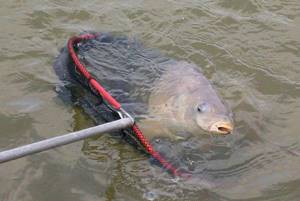
Some fishermen manage to catch carp on the canal
Asp fishing on the canal is very interesting. Catching this predator on the canal is quite difficult, but the process of catching becomes more interesting. Just like pike perch, it enters the canal following the bleak that has arrived to spawn. In spring, the size of the asp in this reservoir exceeds 2 kg, but as the water warms up, real giants come here and are very difficult to catch. You need to catch an asp based on the splash created by this fish when hunting for fry.
The best baits for fishing in this reservoir are:
- small wobblers;
- Devons;
- oscillators.
During the hunt, the asp in the canal is in constant motion, cruising along the coastline. Seeing a bleak emerge from the shallows, he instantly rushes at it, giving himself away with a loud splash.
Perch on the channel is not as popular among spinners as asp and pike perch, but it still often helps out in the absence of biting from other predators.
Interesting! The bulk of perch in the canal sticks to the coastal zone, since far from the shore it itself turns into an object of hunting for larger predators. The perch hides behind the near shore edge and from time to time raids schools of bleak.
In summer, on this reservoir, he prefers to peck on small wobblers up to 5 cm long, while both shallow and deep-water options work. In addition to wobblers, small rotating and oscillating spoons work well in the summer. In the fall, channel perch should be caught with a microjig, using twisters on a jig head weighing no more than 4 g as bait. When fishing with a microjig, you need to fish only the coastal area. The type of wiring is selected experimentally.
Moscow Canal fishing with float tackle
Moscow Canal fishing. The canals, with their strict, landscaped coastline, attract the attention of many fishermen. Here you can not only sit comfortably yourself, lay out your gear, take a swim and wave to the ships passing by, but also choose a “catchy” spot.
According to fishing conditions, channels can be divided into several types. The smallest of them connect lakes with each other, or lakes with rivers serve only as transport routes, especially if there are impassable swamps around. Many such channels are formed on the site of old peat excavations, which were subsequently filled with water.
An example is a huge quarry in the area of the Briket village near Moscow. Fishing in these canals is fundamentally different from fishing in a small enclosed reservoir or river. The larger ones were dug, for example, to straighten the river bed and are transport arteries for ships. In such canals there is a smooth flow and fishing there is no different from fishing in a river.
Fishing with float tackle on the Moscow Canal
The fishing conditions in the canals that connect the basins of different rivers are completely different. Since there is a difference in height above sea level between the river channels, a system of locks is provided in the canals. In terms of the water flow regime, these channels resemble a water pipe: the sluice was closed - the water level begins to fall, the sluice was opened - and a strong current appeared with an increase in the water level.
If there are many ships moving through the canal, the current and water level change literally every few minutes. The water goes one way or the other. This is exactly what the channel is. Moscow. Fish, unlike motor ships and barges, does not always follow the canal. There are “local” fish that live there permanently - these are ruff, perch, bleak, sculpin goby, roach, bream, bersh, pike perch and catfish.
The bulk of fish from the Volga and reservoirs enters the canals from May to October, that is, after spawning and before freeze-up. The rest of the time, “migratory” fish prefer to settle in quiet places in reservoirs. That is why fishing on the canal is seasonal. What attracts fish to the canal?
Firstly, a very good oxygen regime compared to reservoirs. Secondly, the current in the channel carries quite a lot of food. However, it cannot be said that there are more fish here than in reservoirs. It is easier to catch fish in the canal and it is more accessible. But only if the fisherman is able to detect and seduce her.
The fish in the canal are constantly moving. Migrations are associated both with the time of year and with the time of day and operating mode of the gateways. But even if you know the schedule of movement of all ships for a certain day (and therefore the operation of the locks), it is impossible to predict exactly whether there will be a bite today. There are days when the fish comes to the shore in the morning and does not leave it literally until the midday heat sets in.
And it happens that the fish does not want to approach the shore for two or three days and is caught only with bottom gear. Therefore, it is good when several anglers with donks are sitting on the bank of the canal, not far from you. They are a kind of indicators. If they catch fish well, then it will almost certainly bite poorly near the shore.
The most attractive areas for fish in the canal are the coastal areas. Here is the bulk of local food in the form of vegetation, crustaceans and shells. It is convenient to fish here using float gear. To choose the right fishing spot, you need to imagine the approximate topography of the canal bottom.
Why approximate? Yes, because in fact, both the upper edge and the platform in different places of the canal are at different distances from the shore. On the lower edge in some places there are remains of piles that were used to strengthen the shore stones. The area of the upper edge to the shore is covered with underwater vegetation. It is not deeper due to the strong and variable current.
On the lower edge and a little closer to the riverbed there are colonies of shell rock. Food accumulates on the site and is carried away by the current. These are the places that provide the most food and are visited by fish. Therefore, when choosing a place, I equip a plug rod with a maximum length (in this case 16 m, although such a long one is not required during fishing).
I attach a heavy 20-30 gram depth gauge to the hook and methodically examine the area chosen for fishing. First of all, you need to find the bottom edge. If it is located at a distance of 11-14 m from the shore, then the study of the relief can be continued. If the rod doesn’t reach the edge, then I change the place of fishing. Next, I look to see if there is a platform at the bottom, which is usually located at a depth of about 3 m.
If an area at least thirty to forty centimeters wide is found, then we can assume that the place for fishing has been chosen correctly. When the fish moves away from the underwater vegetation, it prefers to stay on this area, since it holds the bait. Only bream and large perch slide down to the lower edge, to their favorite shell rock.
It is better to choose a place in the bends at the bends of the canal. Here the current has a component that is directed towards the shore; it carries the bait closer to the shore, and does not carry it into the riverbed. After choosing a fishing spot, it doesn’t hurt to explore nearby areas. It has been noticed that the best of them are those below which the pit begins.
Often there are more fish above the pit and they are larger than in the pit itself. In the hole, which is close to the shore, the underwater slope is so steep that no bait or natural food lingers on it. Fish simply have nothing to do here. When the fishing location is finally determined, you can begin to equip it, arrange a seat, a fish tank, a table for bait, and a landing net.
The arrangement of the fishing area must be taken seriously, because sometimes the water level rises so much that it simply washes away all fishing equipment. Since the canal bank is rocky, all equipment has to be mounted on metal stands. For the racks themselves, you need to find gaps between the stones. Before lowering it into the water, I always place a large stone in the fish tank so that the current does not hit the fish as easily.
It is very convenient to fish on the canal from the platform, which is equipped with a rod holder, stands for replaceable plugs, tables for bait and bait, and a stand for the cage. The platform is quite heavy, and the water will not be able to wash it away if the level rises sharply (and this is when the current is strongest). There are no places with trees or shade on the banks of the canal.
Therefore, special attention should be paid to protecting the nozzle from the sun. For this, it is very good to use Stonfo tables equipped with special canopies that protect baits not only from the sun, but also from rain. After the fishing spot is equipped, I lay out the plug and three replacement whales, since I always feed not only the platform, but also the lower edge.
In order not to have to change equipment or change the descent on the equipment, you need to have four pillars. Two of them with equipment weighing 1 and 2-3 g are intended for fishing on the site. The other two whales with rigs weighing 3 and 5-8 g are for fishing from the lower edge. Thus, I am fully prepared for the fact that the current may stop altogether or the water will begin to move very quickly.
By the way, many fishermen stop fishing when a very fast current begins. This is incorrect, since it has been noticed that it is at such moments that the largest fish bite - bream and ide. The equipment diagrams are quite simple and are shown in the figure. The equipment (a) is designed for fishing on the platform when the current is weak and smooth. If you want to learn how to catch carp with a “plug”, then this is the place for you.
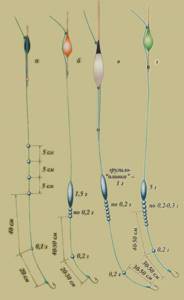
Equipment options: a - for fishing on the site with a weak current; b - for fishing on the site with increasing current; c - for fishing on the lower edge in moderate currents; d - for fishing on the lower edge with increasing current
Equipment (b) is used when fishing on the site when the current intensifies or changes direction. In Fig. (c) shows equipment for fishing on the lower edge, if the current is smooth and not very strong. The difference between equipment (c) and equipment (6) is that below the “olive” there are not three or four, but five to seven weights installed. If necessary, one of the weights can be moved to the sub-height to increase its mass.
Equipment (d) is designed for fishing on the lower edge when the current becomes very strong. Of course, all the equipment given is just guidelines for a novice fisherman. In practice, depending on real conditions, it is necessary to make changes to the design already during fishing: change the length of the leash, the distance between the sinkers, increase or decrease the weight of the catch.
When the equipment is ready and the depth has been measured, you can feed. Fishing practice suggests that the key to success is not in the composition of the bait, but in the feeding technique. If in a reservoir with stagnant water it is possible to feed an area of 1 m2, then such a number will not work on a canal. Any bait thrown a meter further than the float will distract the fish from the fishing point.
It is permissible to throw bait balls half a meter against the current and twenty centimeters further than the float. In this case, the current will bring the bait to the lower edge, but already further downstream. Moreover, this point can be located a meter from the fishing point, or maybe 5-6 m. Therefore, you need to feed as accurately as possible, trying to get into the float, and at those moments when the current changes its direction to the opposite.
Sometimes, especially in the afternoon, the current is steady for several hours. Then you need to feed them the same way as if you were fishing on the river. Previously, a mixture of breadcrumbs and oatmeal in a 3:1 ratio with the addition of 100-200 g of food bloodworms was used as bait. To attract fish, it was necessary to feed it for several days.
True, even today, in order to have a good catch, you often have to bait a place for two or three days, but if it is chosen correctly, the result can be impressive. In my opinion, it is advisable to take with you on a fishing trip for three days 15 kg of “Unikorm” or “Unikorm-roach”, 5 kg of “Sabaneev” super soil, a liter of maggots and a kilogram of food bloodworms. The Sensas current bait “works” very well on the channel.
Bloodworms, bloodworms with maggots, pearl barley and pasta are used as bait on the channel. Infrequently, usually in the late afternoon, large (up to 3 kg) bream and now quite rare for the canal ide take a small worm. The technique of fishing with a plug on the channel consists almost exclusively of keeping the rig exactly on the bait. That is, fishing actually takes place with a “half-bottom”.
If you want to catch a roach, you need to measure the descent to the bottom and keep the equipment in place. The current will lift the hook with bait a few centimeters above the bottom and roach, perch and silver bream will be caught. To catch bream, I do the opposite. I measure the descent using a depth gauge and increase it by 30-50 cm, and sometimes by a meter. If the current is very strong, I move one or two weights from the main one to the sub-weight and put it on the bottom.
When fishing, you must not forget about bait. As soon as the current weakens or stops, you must throw in two or three balls of bait. The same thing is done after a heavy ship has passed by. A wave in the transverse direction creates powerful current eddies near the shore, which, like a vacuum cleaner, wash away bait from the platform and even from the lower edge.
After several motor ships pass one after another, there is practically no bait left at the fishing point. And if you don’t take this into account, you can easily end up without a catch. There is one more subtlety when fishing on the canal. Very often, after feeding, fish begin to be actively caught, but at some point the biting suddenly stops.
This means that a school of large perch or small pike has approached the bait. On the one hand, this is good, because bream or ide will not be afraid of perches and you can patiently wait for the approach of large fish. On the other hand, it can be quite depressing to “chase” a float without bites from the same roach. There are two ways out here.
Throw bait without bloodworms and maggots; after a while the perches will lose interest in such bait. There is another, more interesting option. Some experienced fishermen take a spinning rod with them when fishing. Using a 5-7 cm dark twister, they simply catch perches with bait and continue to catch non-predatory fish.
Author Vladislav Borodkin
The most promising areas for fishing
Having decided on the main fishing objects, the angler must understand in which areas the fishing will take place. There are many promising places for fishing on the Moscow Canal, but certain areas are very popular among anglers.
Canal in the Dubna area
The canal in the Dubna area, stretching from Tempy to the Ivankovskoe reservoir, can generously reward the fisherman with trophies. The depth of the channel in this area is slightly greater than in nearby ones, which was the reason for the increased concentration of a variety of fish. Here you can successfully fish with both spinning rods and float and feeder tackle.
The most interesting area for fishing is located in the area of the old lock. The bottom relief in this place is characterized by a large number of small holes and hollows. The final result of fishing will depend on whether the fisherman is able to find these holes and fish them correctly. It should be noted that the channel in this place is cleared of ice somewhat earlier than in other areas, which allows the fisherman to start the summer fishing season earlier.
